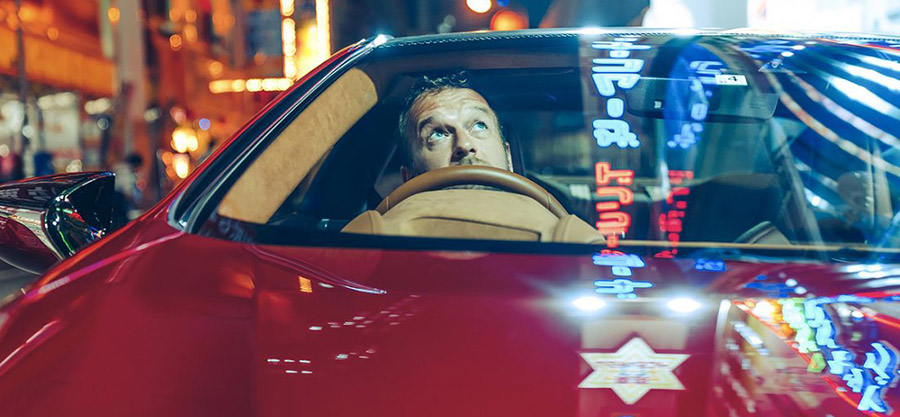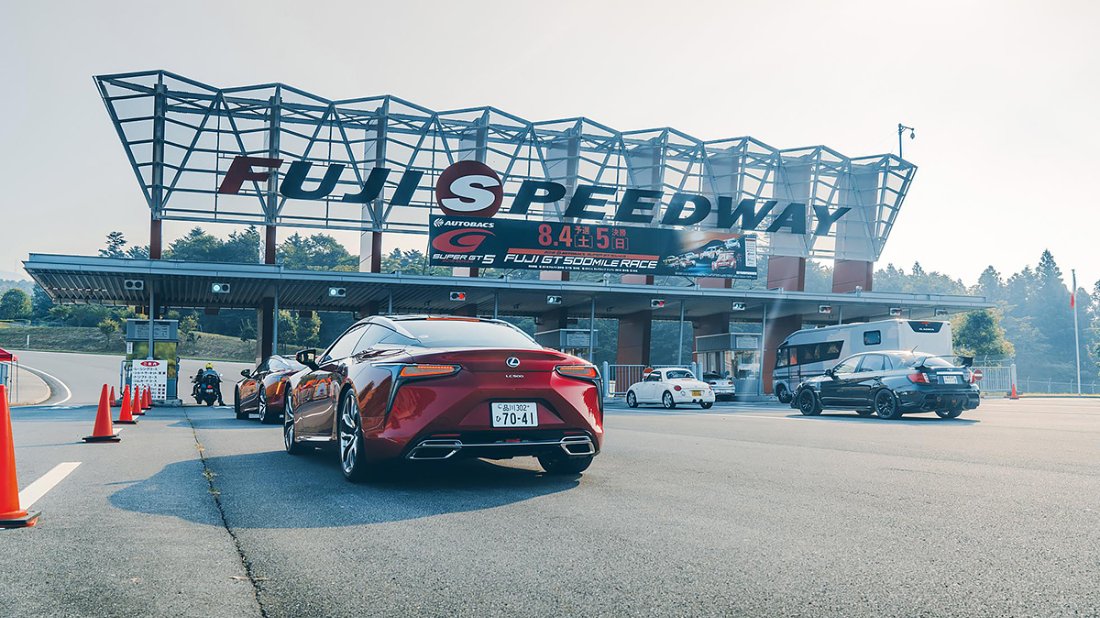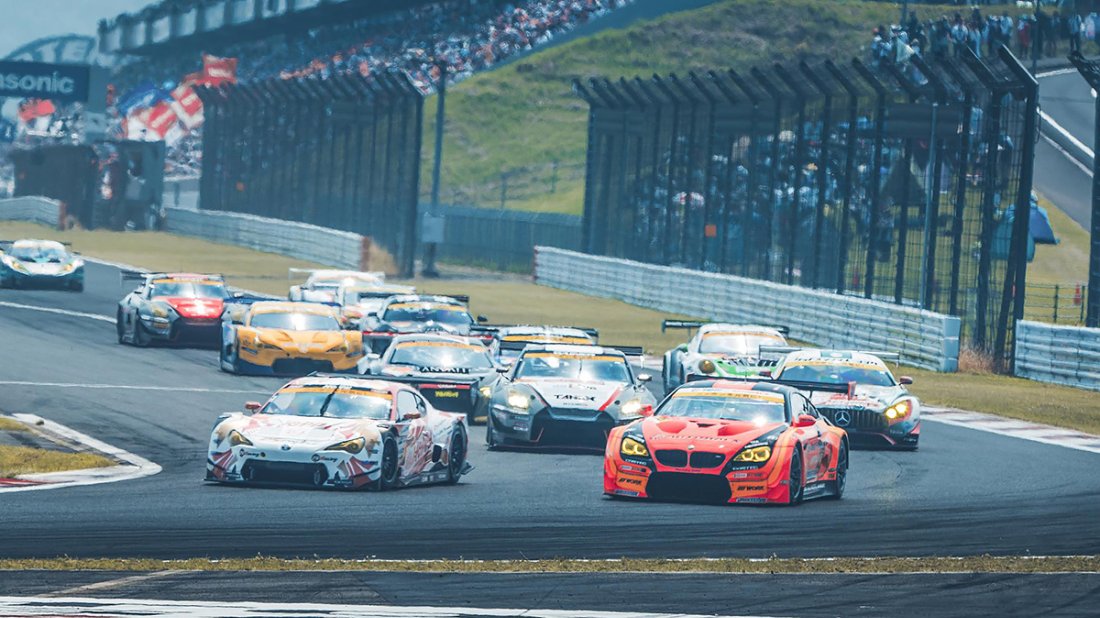Exploring Japan's SuperGT series in a Lexus LC

Everything is familiar, except it isn’t. Not quite. There is shotgun neon, and purposeful bustle. There are huddles of shops, striding people and the pulse of commerce, industrious swarms of taxis and more neon, layered upon each other in a deluge of information that arrives in a rush, breathless and unapologetic. A million little stories played out in seconds, like any modern city in the world.
But there’s a subtle flavour of wrong. The smallest of inconsistencies, as shocking as an unexpected grain of sand caught between your teeth. The neon is in kanji, logographic symbols instead of letters, the shops unfamiliar and often inscrutable, because I’m sure that the store called simply ‘Green Peas’ sells other things, too.
The people are compact and – generally – more precise in their steps, beautiful and interesting and foreign. I may be driving on the left, from the right-hand side of the car, but the taxis are blocky Toyota Crowns and Nissan Cedrics, two-toned and fender-mirrored, heaved from a styling book of 30 years past.
I just stare for a bit. Because even in 2018, Tokyo, from a westerner’s perspective, is so brilliantly other, you never get bored of it. The disconnection of the language, the slippery notions of subtly dissimilar manners and customs; it makes it exciting in a way that feels like learning something new. I cruise past the Park Hyatt and realise that I’m becoming Bill Murray in Lost in Translation. Except my Scarlett Johansson has morphed into a hairy photographer called Mark. Bummer.







I do have some good-looking company, mind you. And although it is showing me the late-night sights, it still has its own flavour of difference. The format might be known; a big, front-engined V8 coupe of the two-plus-no variety (the rear seats suitable only for shelving) and there’s a 10-speed proper auto, rear drive and a long bonnet. Yet it is styled in such a way that it could be nothing but Japanese, the complex weave of angles that no one else manages quite so effectively. It is a Lexus LC500. And it is at home.
There’s another reason we’re here, though. This is a big luxury grand tourer, woofly and accommodating, yet in Japan, it leads a Batman-esque double life in the best race series you’ve probably never heard of.
It’s called Super GT, a hotly contested hardcore series with wing-heavy GT500 racers that run eight to 10 seconds a lap faster than current GT3 cars. The current champion is the KeePer TOM’S LC, piloted by two of the youngest drivers in the entire series, and we’re here to follow their progress at this weekend’s race at Mount Fuji Speedway. But first we have to get there, and I’m taking the scenic route.

Fun stuff: if you’re in Tokyo and a car fan, all you really need to do is get out and about and you’ll see interesting things. Take another step and hit up one of the parking-slash-rest areas off the expressway at night, and you’ll ascend to the next level, because pretty much any evening with good weather sees the automotive underbelly of Tokyo exposed in flashes of chrome and neon.
We head up to the Tatsumi parking area secreted away on the on-ramp of Route 9 on the Shutoko on a Thursday evening, and prove it. Suddenly, I feel like I’m living a cliche, and it is surreal. Tatsumi is on a raised area of the expressway some five or six storeys up, and it has views of the Ariake area and downtown Tokyo behind it. It is also – and somewhat disconcertingly – mobile. Deposited on flexible foundations designed to cope with Tokyo’s not-infrequent earthquakes, Tatsumi wobbles about quite a bit, even when artics rumble past. It’s weird.

It’s also odd that it is full of interesting cars on a random evening. And I do mean full. A finesse of tastefully modified Lexi – GS-Fs and IS-Fs – sit gleaming in several spots, a couple of FD RX-7s, a pair of R34 Skylines, a violently green – but otherwise standard – Lamborghini Gallardo.
There are modified GT86s, Golfs and even a brand-new Alpine A110. Everyone swarms the LC500, interested despite the quality of the other cars here, right up until a blue Aventador dripping ludicrous neon rolls up the entrance road, revs the hell out of its V12, spurts flames like a misfiring afterburner and then leaves at full chat. I just sort of stand with my mouth open. It’s hellishly hot and humid, 37 degrees and 80 per cent, even at night, I have crushing jetlag and don’t really understand what’s going on. But it’s brilliant, Japan living up to every expectation.
Next day, we go and visit a few places, meet a few people, have a nose around Tokyo and its environs. The LC is docile and comfortable, albeit low and wide and not entirely suited to town work. So we head out to the Hakone Turnpike for a bit of a drive.
Essentially a scenic toll road, Hakone is brilliant for getting out of the city, and the LC laps up every single sweeping curve. It’s not pretty at the top, the mountains austere, and withdrawn, and grumpy. The cloud a mantle of grey drawn about the tops like a cloak of disappointment.

But the LC feels properly old-school, and happy to play. It’s strange, but despite the tech obviously loaded into the LC, the V8 version feels surprisingly natural. With a lot of modern performance cars, the art of driving becomes boiled down into the process of deciphering acronyms to figure out why a car is doing what. You don’t feel any more, you translate.
Not so with the LC; it may have adaptive damping and selectable modes via the stumpy antenna on the side of the instrument binnacle, but when you get down to it, it just feels like a nicely sorted, big V8-engined GT. It’s not whip-smart and devilish, but it is lithe and long-legged, with plenty of edge to keep you interested.
And it makes a noise that pushes back the mist, the engine the river from which the experience floods. It’s flow rather than force, not a car that goes lightning-fast, as such. It just collects all the verbs you can think of, and condenses them into one diamond-hard sense of doing.
It is not, however, what you might consider to be the perfect base for a racecar. It’s too luxurious, too urbane, too suited to its aesthetic pitch. But when we eventually roll up to Fuji the next day after a glorious three-hour wander through the mountains, we glide into the pitlane to find the motorsport Hyde to the roadgoing LC’s Dr Jekyll.
The sun only winched itself in the sky and started chucking around daylight about an hour ago, and already it’s 40 degrees, but seeing the racing LC ratchets up the heat a little more. The KeePer TOM’S LC is Manga made real, swollen with vented carbon arches, flattened to the floor, shaded by its own enormous wings. And it looks like it’s going to bite someone’s head off.
You can see the resemblance, that this is an LC, but once you dig a little deeper, you find that the Super GT cars are familiar skins draped over a skeleton of hardcore motorsport. The tub is carbon, the panels are carbon, the wings are carbon.
The motor is the class-standard 2.0-litre four-cylinder with a Garrett blower, supposedly producing around 550bhp – though we later find out it’s probably nearer to 680. And although it’s a shame it’s not a V8, the raw and guttural edge to the noise makes up for the lack of cylinders. There’s a six-speed sequential paddle shift, carbon brakes, and the whole thing weighs in at just over a tonne. Getting on for half the weight of the road car.







Six LC outfits fight tooth-and-nail in the Super GT500 championship with main rivals from Nissan (GT-R) and Honda (NSX), all with the ‘same’ engine. And they go fast. Racing on the same circuit as GT300 class cars (essentially semi-production GT3), they circulate at Fuji so quickly that they lap the GT300s every fourth lap.
It’s like Le Mans condensed into a violently short track, each 500-mile race a battle royale of overtaking, tactics and endurance, pitched against a background of loads of different cars: there are GT-Rs and NSXs, Audi R8s and Lamborghini Huracáns, AMG GT Rs and a Bentley Continental. There’s even a GT3-spec Toyota Prius. Really.
Exciting doesn’t quite cover it, and although it also means that it can be quite confusing – especially with Japanese-only commentary – you get more overtaking in the first 10 minutes of racing than you do in an entire season of Formula One. Jenson Button decamped here after emerging from F1 to race the Raybrig NSX-GT for Team Kunimitsu, and you can see why – this is undoubtedly a racer’s series.

... you get more overtaking in the first 10 minutes of racing than you do in an entire season of Formula One.
My first impressions of the KeePer TOM’S crew are that they are… young. Both born in 1994, Japanese local Ryo Hirakawa and New Zealand’s Nick Cassidy are boyband fresh and disturbingly focused. Reigning champions in the series, they both graduated from various formulae before ending up in Super GT, and they both patently love racing these cars – citing the ongoing tyre war, closeness of racing and sheer speed of the Super GT cars as the things that keep them engaged.
The racing is close – close enough to warrant weight penalties for balance-of-power – and there’s a Rubik’s Cube of strategies to contend with when planning race versus championship strategy. Qualification takes place, and frankly, I still have no idea what’s going on, and leave the circuit knowing only two things: our KeePer TOM’S car qualifies seventh, and the ferocity of the racing and overtaking leaves you with an elevated heartbeat and a slight migraine.
Race day, and Fuji is a circus. There are people dressed in mascot costumes who will obviously die when the sun reaches its peak, grid girls dressed in plastic shorts and towering heels, dragging with them attendant gaggles of middle-aged men who treat them like royalty. One set of drivers faces the TV cameras wearing cat ears and paw gloves (I’m not kidding), and there’s an aerial acrobatic display which concludes with the stunt plane flying down the main straight at just 20ft of elevation. I’m accosted by a man dressed as a blue devil who insists I take his picture and asked politely by a tiny Japanese woman if she can take mine. I’m still not sure why.
We decamp to the first corner to await the start, and when the flag drops, the bulls**t stops. The Super GT cars have a rolling start half a lap ahead of the GT3s, and I swear I thought not a single one would get around the first right-hand bend, such was the speed at which they approached the corner. They don’t so much brake as delete speed, still turning in at aero-assisted triple-digit mph. KeePer TOM’S gets through, and I watch aghast as an angry swarm of GT3s fusses through the first corner a moment later.

How they don’t all immediately crash is beyond me. Within two or three laps, the Super GTs are lapping the GT3s and I lose track completely, befuddled by a confusion of GT3s being absolutely scythed by the Super GT cars. This has to be one of the most intense forms of racing anywhere – for drivers of both classes. Not only do you have to constantly battle with your peers, you have to watch for vehicles either going much, much slower, or ten seconds a lap faster. There simply is no let-up, no place to catch your breath, no respite. And they do this for 500 miles. It’s berserk.
Cars crash, things explode, drivers are exchanged. When the whole thing shakes down, our KeePer TOM’S car has finished an absolutely storming second place, behind the au TOM’S LC of Kazuki Nakajima and Yuhi Sekiguchi, with a pair of NSX GTs just behind. It’s been a frenetic, hyperactive and slightly bonkers race, and by the end it’s a relief to sink into the roadgoing LC500 and just… breathe.
On the journey back to Tokyo, the main thought is that it’s surprising that Super GT isn’t more popular globally. Set against a backdrop of overly managed motorsport like F1, this is an adrenaline-fuelled delve into the dark side, where drivers are forced to really drive. It’s characterful, and exciting and a bit weird.
Which is pretty much the conclusion I’ve also come to with the LC500. Lexus has an image of producing well-made but slightly boring machines generally, punctuated by moments of pure brilliance. And the LC500 feels like a blue-collar LFA; styled like a spaceship, but with the kind of driving experience that puts a hard-to-shift grin on your face.
In a world where the hegemony feels like it’s closing in, Lexus has made a statement, and it’s a strong one. We track back towards the glittering lights of the city buzzing from the day’s racing, V8 soothing away the miles, and smile. Like I said, everything is familiar, except it isn’t. And that’s what makes it so utterly special.
- Tom Ford
















